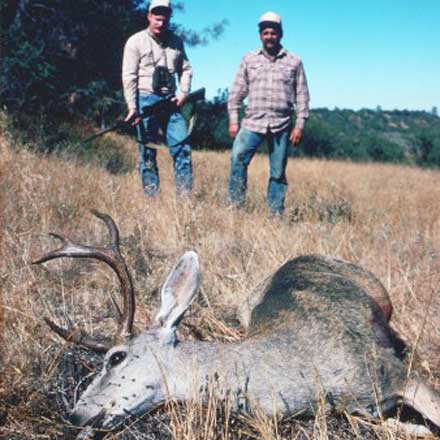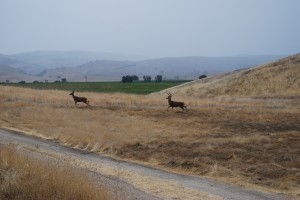
As I write these lines, it’s a blistering August across the U.S. That’s not all bad. Winter and spring are behind us, summer is on the wane, and autumn is coming soon. For those among us who are deer hunters, that means our season is right around the corner…but that depends a whole lot on where you live. Along California’s Central Coast the “early” archery season is over, and rifle deer season is in full swing.
Undoubtedly, this is surprising to many,
 but the earliest deer season in the Continental United States is in California’s “A Zone,” a huge swath of country running along the coast and coastal mountains, roughly from Ventura northward for several hundred miles. For at least a generation, the archery deer season has opened in mid-July with the rifle season opening the second Saturday in August and running through about the third week in September. I’ve hunted in this area for more than 30 years and have lived there nearly 20. I’ve often asked why the deer season is so early. All I’ve ever gotten is that it’s traditional, with the original reasoning seemingly lost.
but the earliest deer season in the Continental United States is in California’s “A Zone,” a huge swath of country running along the coast and coastal mountains, roughly from Ventura northward for several hundred miles. For at least a generation, the archery deer season has opened in mid-July with the rifle season opening the second Saturday in August and running through about the third week in September. I’ve hunted in this area for more than 30 years and have lived there nearly 20. I’ve often asked why the deer season is so early. All I’ve ever gotten is that it’s traditional, with the original reasoning seemingly lost.
These coastal deer are a bit different from other mule deer and blacktails. By the way, we locals do call them “blacktails,” but in most of the coastal zone, they’re really amixture between Columbia blacktail to the north and California mule deer to the south. It’s almost impossible to draw definite lines, but in the northern part of the “coast zone” the deer are probably true blacktails, while in the south they are definitely California mule deer, a race that is somewhat smaller and lighter in color than the Rocky Mountain mule deer. In the middle, along my Central Coast, our deer are mixture, and it probably doesn’t matter anyway. This is harsh, drycountry in summer and the deer rarely grow big antlers, but we love them for what they are, and like local hunters everywhere, we love our deer season.
While it can always be cool right along the ocean, the coastal mountains are an inferno in July, August, and September, so the early season doesn’t seem to make much sense. Except winters and springs are soft, so unlike a lot of deer herds, the...
hotsummer months are the stress period for these deer.

This puts the rut and the antler growth cycle considerably earlier than with most mule and blacktail deer. Our deer are pretty much in full velvet by the time archery season opens in July. When rifle season opens, most bucks have already started to scrape the velvet, and by late August most
bucks are in hard antler. As we know, some states consciously set deer seasons before the rut, some after, and a few before. My guess is this season was planned to take place before the rut, which, in this area, is usually in full swing the last week of September.
This means that, in most years, we start to see bucks chasing the last week of the season. By then, the weather may have cooled a bit, and the days are getting a bit shorter. But, serious coastal deer hunters don’t wait until the last week! It’s tough in midsummer, with long days and short nights. The ocean is close enough that there’s usually a major temperature swing, 40 and even 50 degrees, between mid-afternoon and midnight, but the afternoons are hot enough that the cooling isn’t noticeable until just before sundown, so deer movement is unlikely until that last hour before dark. It’s back home or to camp at ten p.m., then up again at three. Mornings are glorious, cool enough to need a light jacket. But, the cool doesn’t last long since, so there’s only two, possibly three hours of good morning hunting before it gets too hot, and the deer have all retired to their bedding grounds.
Much of the hills are covered by dense chaparral, almost impenetrable on foot and impossible to glass into. So we glass for deer around the edges, in the saddles and open ridges, and we avoid the poison-oak-choked valleys. In a good acorn year, we look in the oak grasslands. Often the temptation to nap through the hottest hours is unavoidable, but if you can find some shade, then sitting on a ridge overlooking ponds or stock tanks is never a bad idea—water is key, and sometimes you can catch a buck coming to water at midday.
No matter where or when we look, we don’t see a lot of deer. Deer densities are low anyway, and overall numbers have been for some...
years. Drought, uncontrolled predators, game-fenced vineyards blocking movement, you name it. Hunter success is also fairly low. A “legal buck” must have a fork in the upper third of one antler. This has been traditional for many years, so we see a lot of spikes…and we don’t see a lot of legal bucks.
A “legal buck” must have a fork in the upper third of one antler.
In fact, the hunting is tough enough that most coast zone hunters rightfully consider any legal buck a worthy trophy. Realistically, a lot of bucks are big forkies at full maturity—“big” meaning, in this area, a bit of mass and perhaps a spread in the upper teens! Relatively few bucks exceed three points per side, and four-by-fours are exceedingly rare. It doesn’t matter; these little coastal deer are our deer, and the summer season is our deer season, enjoyed annually by thousands of hunters all along the California coast.